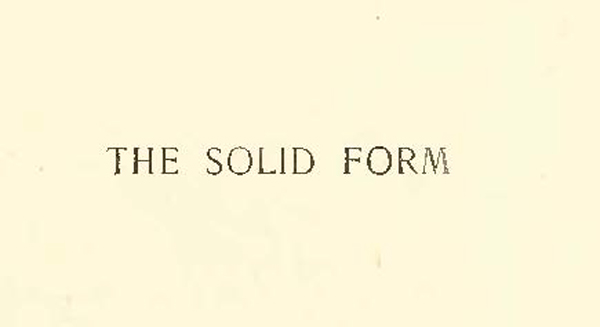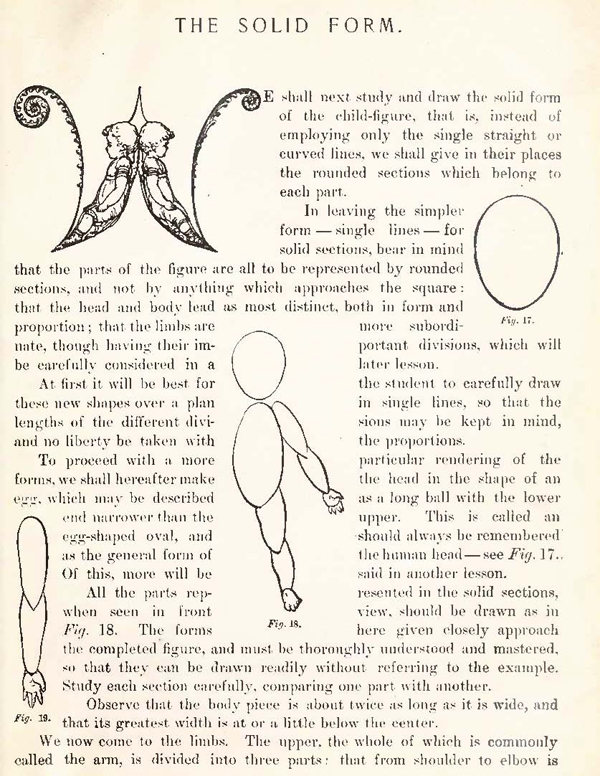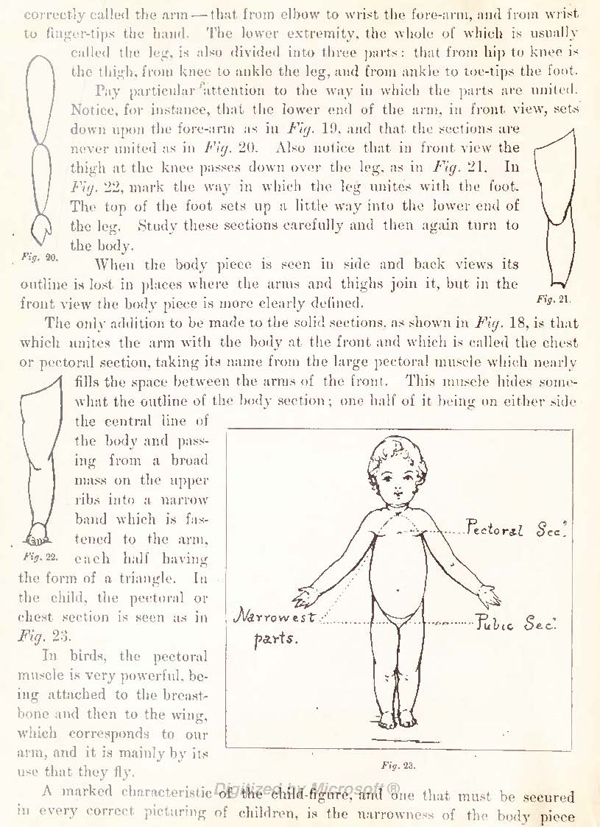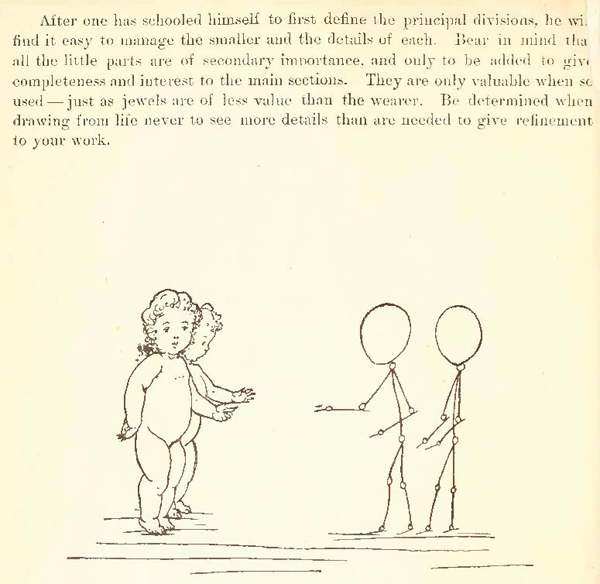Home > Directory of Drawing Lesson > People > Draw Kids > How to Draw Children and Their Solid Forms
How to Draw Children and Their Solid Figures and Forms with This Drawing Lesson
|




[The above words are pictures of text, below is the actual text if you need to copy a paragraph or two]
THE SOLID FORM.
We shall next study and draw the solid form of the child-figure, that is, instead of employing only the single straight or curved lines, we shall give in their places the rounded sections which belong to each part.
In leaving the simpler form - single lines -f or solid sections, bear in mind that the parts of the figure are all to be represented by rounded sections, and not by anything which approaches the square: that the head and body lead as most distinct, both in form and proportions; that the limbs are more subordinate, though having their important divisions, which will be carefully considered in a later lesson.
To proceed with a more particular rendering of the forms, we shall hereafter make the head in teh shape of an egg, which may be described as a long ball with the lower end narrower than the upper. This is called an egg-shaped oval, and should always be remembered as the general form of the human head - see Fig. 17. Of this, more will be said in another lesson.
All the parts represented in the solid sections, when seen in front view, should be drawn as in Fig 18. The forms here given closely approach the completed figure, and must be thoroughly understood and mastered so that they can be drawn readily without referring to the example. Study each session carefully, comparing one part with another.
At first it will be best for the student to carefully draw these new shapes over a plan in single lines, so that the lengths of the different divisions may be kept in mind, and no liberty be taken with the proportions.
The completed figure, and must be thoroughly understood and mastered, so that they can be drawn readily without referring to the example. Study each section carefully, comparing one part, with another.
Observe that the body piece is about twice as long as it is wide, and that its greatest width is at or a little below the center.
We are now going to talk about the child's limbs. The upper, the whole of which is commonly called the arm, is divided into three parts: that from shoulder to elbow is an important divisions, which will alter the lesson.
Tell the student to carefully draw in single lines, so that the visions may be kept in mind, the proportions.
Pay attention particularly to rendering of the the head in the shape of an as a long ball with the lower upper. This is called an -should always be remembered' the human head — see Fig. 17 said in another lesson.
resented in the solid sections, view, should be drawn as incorrectly called the arm—that from elbow to wrist the fore-arm, and from wrist to finger-tips the hand. The lower extremity, the whole of which is usually called the leg, is also divided into three parts : that from hip to knee is the thigh, from knee to ankle the leg, and from ankle to toe-tips the foot.
Pay particular attention to the way in which the parts are united.
Notice, for instance, that the lower end of the arm, in front, view, sets down upon the fore-arm as in Fig. 19, and that the sections are never united as in Fig. 20. Also notice that in front view the thigh at the knee passes down over the leg, as in Fig. 21. In Fig. 22, mark the way in which the leg unites with the foot. The top of the foot sets up a little way into the lower end of the leg. Study these sections carefully and then again turn to the body.
When the body piece is seen in side and back views its outline is lost in places where the arms and thighs join it, but in the front view the body piece is more clearly defined. Fig. 21.
The only addition to be made to the solid sections, as shown in Fig. 18, is that which unites the arm with the body at the front and which is called the chest or pectoral section, taking its name from the large pectoral muscle which nearly fills the space between the arms of the front. This muscle hides somewhat the outline of the body section ; one half of it being on either side the central line of the child-fin-ure and one ne that must be secured in every correct picturing of children, is the narrowness of the body piece of the body and passing from a broad mass on the upper ribs into a narrow band which is fastened to the arm, Fig. 22. each half having the form of a triangle. In the child, the pectoral or chest section is seen as in Fig. 23.
In birds, the pectoral muscle is very powerful, being attached to the breastbone and then to the wing, which corresponds to our arm, and it is mainly by its use that they fly.
A marked characteristict of under the arms and at the lower end which is called the pubic section (Figs. '23 and 23 a).
Do not forget that in children the arms are placed high, leaving little room for the neck, and that the top of the arm makes the shoulder. The body piece being nc.rrow near the head we find that when the arms are added the shoulders are near together. It may be set down as a rule that the shoulders of a child are high and narrow.
It is a little curious that most people, when they begin to draw children, fall into certain errors in proportion which surely result, however well all else may be drawn, in forms most unchild-like. By way of precaution at the outset, it will be well to point out some of these mistakes so often made.
First, the shoulders are usually drawn too wide. Now, it takes years for the shoulders to grow broad, and that is a marked feature of the adult figure. Then the legs are likely to be too long. This again is a serious defect, as it reduces the proportionate length of the body, which in the child is the longest single division. Another fault comes from making a long neck, and the head heavy at the lower end. Avoid such errors, and carry in mind the rule that of the whole height three fifths must be above the hips and two fifths below the hips. Compare Figs. 24 and 24 a and note how in the one, with a very few lines which keep to the right proportions, the child form may be obtained, and how in the other, by not observing correct proportion, the child-like character is wholly lost.
Sometimes a drawing that in certain parts is very contradictory to the rules of good proportion. will be so correct in others, and so admirable in details, that the whole passes for good and clever work. This is possible only when the worth of the parts that are wrong is less than the value of those that are right. As an example, Fig. 24 could not indicate anything but the baby form, however carelessly the details might be drawn, but on the contrary the proportions in Fig. 24 a would never suggest a child even if the minor parts were most correctly given, since so much that is essential to the child-figure has been denied it.
The largest sections are always most easily distinguished, and the . just consideration of them (which would seem easy) lies at the foundation of good drawing, yet they are too often slighted, and attention given to minor parts and details, at the sacrifice of time and labor in the first place, and of a good result in the end.
After one has schooled himself to first define the principal divisions. he wi. find it easy to manage the smaller and the details of each. Bear in mind tha all the little parts are of secondary importance, and only to be added to the completeness and interest to the main sections. They are only valuable when sc used — just as jewels are of less value than the wearer. Be determined when drawing from life never to see more details than are needed to give refinement to your work.




